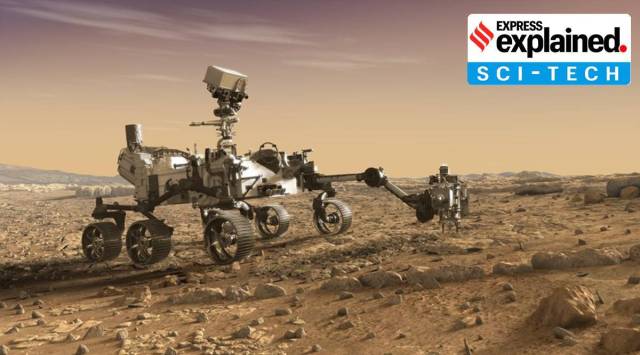- India
- International
Red Planet Day: The many missions that brought humans closer to Mars
On November 28, 1964, the NASA mission Mariner 4 was launched, which ended up capturing significant information on, and photographs of, Mars for the first time. Here is a look at the mission, and the other voyages spacecraft have made to Mars.
 Perseverance, the most advanced, most expensive and most sophisticated mobile laboratory sent to Mars. (Photo: Twitter/ @NASAPersevere)
Perseverance, the most advanced, most expensive and most sophisticated mobile laboratory sent to Mars. (Photo: Twitter/ @NASAPersevere)Commemorating the day one of the most significant space missions to Mars was launched, November 28 is marked as Red Planet Day. On this day in 1964, the United States launched the space probe Mariner 4 on a course towards Mars, which it flew past in July 1965, sending back pictures of the red planet.
This was the first time that a spacecraft undertook the first flyby of the red planet, becoming the first-ever spacecraft to take close-up photographs of another planet. Subsequently, considerable interest has been sparked around Mars, and missions have been launched, to the point that at present, the idea of settling a colony of humans on Mars (as suggested enthusiastically by billionaire Elon Musk) has also been put forth.
Here’s a brief look at how Mars became prominent in the popular imagination, aided by crucial space missions that helped advance knowledge about it.
Early 19th century
In one of the earliest known cases of a fascination with the planet, NASA’s website notes how in the late 19th century, Italian astronomer Giovanni Schiaparelli claimed to have observed linear patterns on the surface of the planet that he called canali. This was mistranslated into English as canals, leading some to believe canals were built by intelligent beings on Mars — an early instance of Mars being thought to have life, similar to Earth.
Although that idea fell out of favour among scientists by the early 20th century, it did permeate into science fiction as well as popular culture, says NASA, helped by the fact that Mars was at a similar distance from the sun as the earth was and thus, shared certain structural characteristics.

1964: Mariner 4
After an eight-month voyage to Mars, the Mariner 4 helped humans see images showing lunar-type impact craters, some of them touched with frost. A television camera onboard took 22 pictures, covering about 1% of the planet. These photos were transmitted to Earth in four days.
“Although originally not expected to survive much past the Mars flyby encounter, Mariner 4 lasts about three years in solar orbit, continuing long-term studies of the solar wind environment and making coordinated measurements with Mariner 5,” according to the NASA website.
The photographs also revealed a cratered surface resembling the Moon, although because of their limited range, they failed to cover the more geologically diverse features that we know about now. “All in all, these findings dashed many scientists’ expectations of Mars as a place hospitable to life,” NASA said.
Viking missions of the 1970s and the 1980s
The Viking missions in the mid-seventies carried out the first chemical analysis of Martian soil, as well as four biology experiments to detect biological activity, wrote Dr Amitabha Ghosh, a NASA Planetary Scientist based in Washington DC, in The Indian Express.
In the early 1980s, scientists hypothesised, based on mineralogic composition and rock texture, that certain meteorites might have a source region in Mars. In 1984, a study showed that the isotopic composition of rare gases (Xenon, Krypton, Neon and Argon) matched the isotopic ratios of the Martian atmosphere measured by the Viking spacecraft. This discovery provided a way for geochemists to study Martian samples – and provided a huge boost to our understanding of the geochemical evolution of Mars.
Odyssey, 2001 and water on Mars
In 2001, the Gamma Ray Spectrometer on board the Mars Odyssey spacecraft detected a fascinating hydrogen signature that seemed to indicate the presence of water ice. But there was ambiguity – this was because hydrogen can be part of many other compounds as well.
NASA’s Phoenix landed on the Martian North Pole in May 2008, and survived for about 150 days. The robotic arms of Phoenix scooped soil and ice from the surface, heated the material in eight ovens, and measured the composition of the gases with a mass spectrometer. The Phoenix mission established conclusively that the initial discovery of hydrogen by Mars Odyssey in 2002 was indeed water ice.
Beyond the West
After the Cold War, which saw intense competition between the USSR and the US in terms of deepening their forays into space, other countries also launched their explorations.
NASA has a lander (Mars Insight), a rover (Curiosity), and three orbiters (Mars Reconnaissance Orbiter, Mars Odyssey, MAVEN); India has an orbiter (Mangalyaan-1); the EU has 2 orbiters (Mars Express and ExoMars Trace Gas Orbiter); and China and UAE will have an orbiter each (Hope and Tianwen-1 respectively).
The UAE mission will study the Martian atmosphere, and will seek to address the billion-dollar question of how and why Mars lost its atmosphere. India’s Mars Orbiter Mission — a technology demonstration venture — carried five scientific payloads (total 15 kg) collecting data on surface geology, morphology, atmospheric processes, surface temperature and atmospheric escape process.
EXPRESS OPINION
May 26: Latest News
- 01
- 02
- 03
- 04
- 05







































